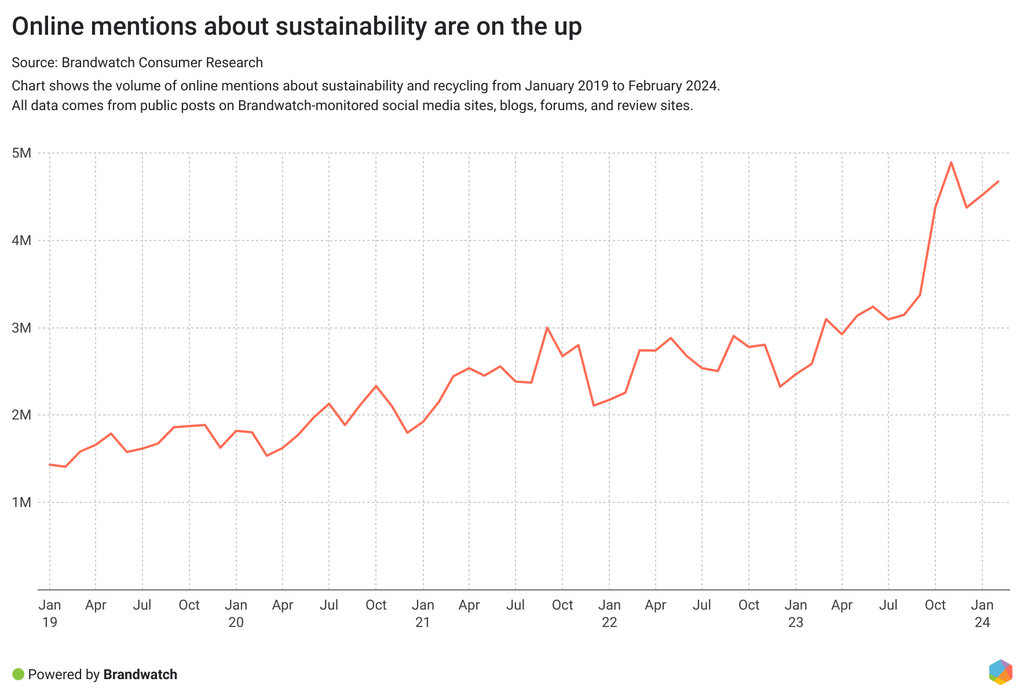With consumers demanding greener operations from their favorite brands, companies need to listen to see a benefit to their bottom line.
But what methods should brands implement to make customers aware of their sustainability efforts?
We dove into the online sustainability conversation to see what the sentiment is towards recycling and sustainability, and discover how you can market sustainable products and practices the right way.
Do consumers actually care about sustainable products?
We used Brandwatch Consumer Research to look at mentions about sustainability on social media, blogs, forums, and review sites over the last five years. And the results were intriguing.
Online mentions about sustainability and recycling are at the highest they’ve been. In the last few months, a number of things have contributed to this uptick in climate concerns, including Nigeria and Germany signing agreements towards sustainable developments and sustainable initiatives being revealed at technology event CES 2024.
In November, online mentions hit a peak of almost 5 million, showing just how important sustainability is for consumers right now.
So, how does this translate to business?
In January and February this year, 52% of online mentions about sustainability and recycling also mentioned brands, products, and services. This means consumers are actively discussing brands and products that promote – or avoid – sustainability.
A huge percentage of mentions about sustainable brands and products were positive, showing that consumers are quick to celebrate companies for their efforts towards sustainability.
Alternatively, it’s also common for brands to come under fire for not acknowledging or working towards incorporating greener practices.
So, it’s clear that working towards having a more sustainable brand or product is important for consumers. But how can you translate these efforts into bottom-line growth?
The power of marketing your sustainability efforts
Interestingly, some brands are anecdotally reporting an inability to generate sufficient consumer demand for sustainable products. So it’s understandable that some brands are skeptical about investing in greener operating methods.
But what do the facts say about the profitability of incorporating ESG (environmental, social, and corporate governance) initiatives into businesses?
McKinsey set out to answer this question: Is it actually beneficial to a brand’s bottom line to implement sustainability?
And as it turns out, yes – it is. Products making ESG-related claims averaged 28% cumulative growth over the past five-year period, versus 20% for products that made no such claims.
As McKinsey puts it, “Creating such products turns out to be not just a moral imperative but also a solid business decision.”
So, why are some brands not seeing any success with their sustainability efforts? In part, the answer can be found in their marketing efforts.
Marketing sustainable products effectively could be the deciding factor on whether consumers are receptive to your ESG activities. So, let's look at how your brand can ensure you benefit from your green initiatives.
How to market your sustainability efforts effectively
Let’s look at some ways you can keep sustainability at the forefront of your marketing efforts, and look at ways other brands are seeing success.
Release a report on your sustainability efforts
A deep dive into your business’ current sustainability standings is always a good place to start for any company wanting to improve their green initiatives. While this can be great for brands to have a format to assess their sustainability efforts internally, sharing your sustainability report online can also bring great publicity.
You don’t need to be perfectly sustainable to put effort into creating a sustainability report, either. If anything, acknowledging your downfalls and committing to improving over time is exactly what consumers want to see.
If you have a report, or you’re looking to make one, make sure you show it off online. Make it visible on your website, share it on social media, and consider keeping consumers in the loop over email.
Shipping and logistics company Maersk is a great example of leading with sustainability reports. The brand releases one every year in accordance with regulations to keep themselves accountable – but they don’t shy away from shouting about the report. Their ESG commitments – which include a comprehensive strategy to reach net zero across their business by 2040 – have a dedicated page on their website, making it easy for customers to learn and understand that sustainability is one of Maersk’s core values.
Customers are receptive to this kind of content too – there were over 13k mentions about Maersk’s sustainability initiatives on social media last year. And over 65% of emotion-categorized mentions expressed joy, proving there’s a largely positive reception to these initiatives.
The brand also regularly posts about their latest environmentally-friendly schemes to a receptive audience.
Committing to sustainable practices and demonstrating concrete changes to your operations can often be enough for customers (and potential customers) to be pleased with your green initiatives. So, if you have the resources, consider putting together – and showing off – a report analyzing your commitment to sustainability.


